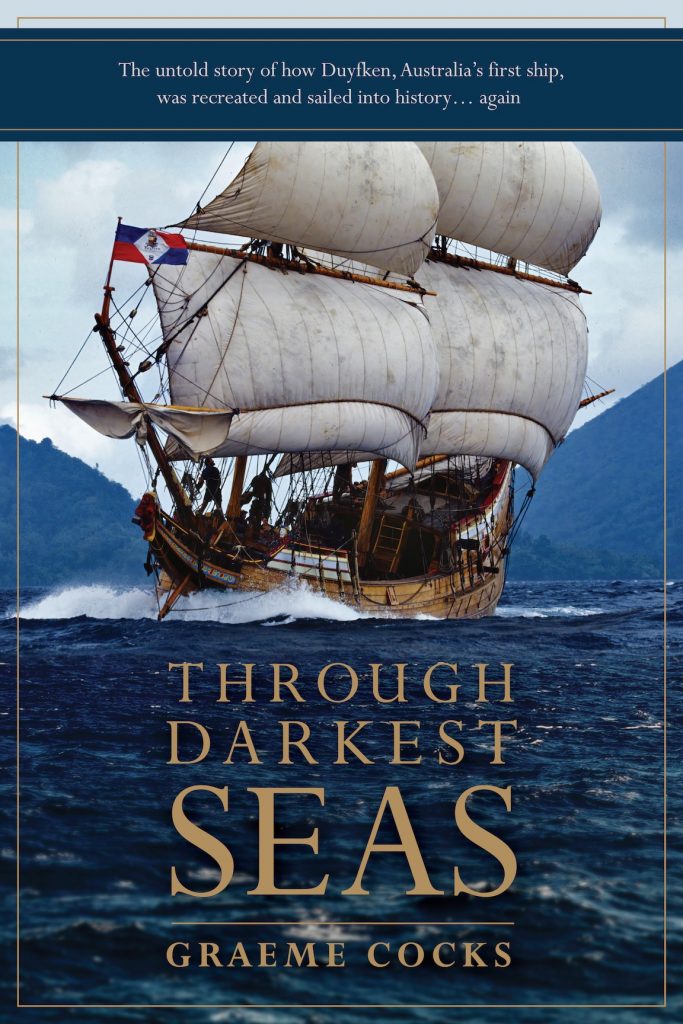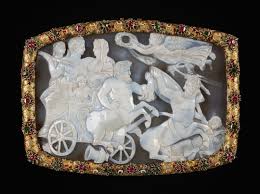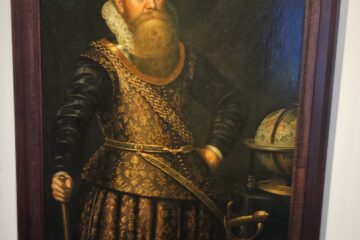Graeme Cocks. Through Darkest Seas. Inglewood: Motoring Past Vintage Publishing, 2023. E-book.
Review by Jorien van Beukering
Ever wondered what it would be like to build a replica of a seventeenth-century ship of exploration? If so, look no further than Graeme Cocks’ new book Through Darkest Seas, which tells the story of a dedicated group in Fremantle, Western Australia, who had this dream and made it a reality. Through Darkest Seas relates how the Duyfken 1606 Replica Foundation planned, constructed and then sailed a replica of the Dutch jacht or scout ship Duyfken – whose crew in 1606 were the first Europeans to make landfall on Australian soil – from Fremantle to Indonesia and back to Australia; a year later they sailed the Duyfken replica halfway around the world to The Netherlands. Through Darkest Seas is at once a history book, a story of collective determination and love for an ambitious ship-building project, a personal account of tribulation and triumph over a 20-year undertaking, and a story of contemporary Australia coming to terms with its history. A must-read, Through Darkest Seas is sure to interest a wide range of readers.
Through Darkest Seas recounts the Duyfken (‘Little Dove’) replica project from the perspective of author Graeme Cocks, who was involved in the project from its inception in 1993 until 2013 and was for many years its director. Cocks’ book can be split into four parts: the initial idea of a Dutch replica ship in Fremantle in the 1990s and the construction of Duyfken (Chapters 1-9); a reenactment voyage to Indonesia and north Queensland in 2000 (Chapters 10-22); Duyfken’s journey to The Netherlands in 2001-2002 to participate in the 400-year anniversary celebrations of the founding of the Verenigde Oostindische Compagnie (VOC, United East India Company) (Chapters 23-28); and reflections by the author on the end of his involvement in the project in the 2010s (Epilogue). Black-and-white photographs of Duyfken are appended to the book and enhance the text.
One of the strengths of Through Darkest Seas is Graeme Cocks’ personal account of his involvement in the Duyfken project. Even though Through Darkest Seas was written during the Covid-19 pandemic nearly thirty years after the replica project’s beginnings, the keen interest and excitement Cocks felt for Duyfken spill over onto the pages of his book. His enthusiasm is infectious: readers with no prior knowledge of Duyfken (original or replica) are sure to become fascinated with this ship’s many stories and rich past.
Cocks’ honesty about the vicissitudes of the project is equally compelling. Through Darkest Seas testifies that building a replica ship is no mean feat and the book bears witness to the personal sacrifices made to keep the project running. This is particularly highlighted by Cocks’ account of Duyfken’s voyages, where he contrasts the experiences of the onboard crew with his own efforts to arrange berths, crew accommodation, supplies and repairs ahead of the ship’s arrival in each port. Cocks’ highlighting of the behind-the-scenes work conducted by shore crew during voyages and the mammoth efforts undertaken by a handful of individuals over many years to secure the funding needed to continue the replica, is an important and until now largely untold part of the Duyfken story.
Another strength of Through Darkest Seas is its acknowledgement of historical wrongs in the original Duyfken story and attempts by the Foundation to address these. The account of the replica’s crew asking Traditional Owners at the Pennefather River in north Queensland for permission to land is a particularly powerful act that contrasts sharply with the actions of the original Duyfken crew at this site in 1606 (Chapter 21). Similarly refreshing are evolutions in the author’s perspective on Duyfken’s history: awareness that the VOC was responsible for slavery, murder, and dispossession of lands in its quest for wealth through spices, and realisations about the problematic nature of sailing a replica Dutch VOC ship to Indonesia, a former Dutch colony. Although the book could have delved into this further, Through Darkest Seas is commendable for its acknowledgement of the “dark shadows” (p.268) that are also part of the Duyfken story.
Through Darkest Seas adds to existing publications about both the original Duyfken and the replica ship and will appeal to readers interested in maritime history, shipbuilding, Australian history, Australian-Dutch history, Australian-Indonesian connections, Dutch journeys of exploration, Fremantle & Western Australia, and reenactment stories. Despite some spelling and grammar errors, a missing Chapter 17 (Chapter 16 flows straight into Chapter 18), minor repetition across chapters, and rich but at times excessive profiling of the people involved in the Duyfken replica project, Through Darkest Seas is an enthralling read that is bound to capture the imaginations of its readers.
This review is of the e-book version of Through Darkest Seas and does not account for differences with the hardcopy book.



